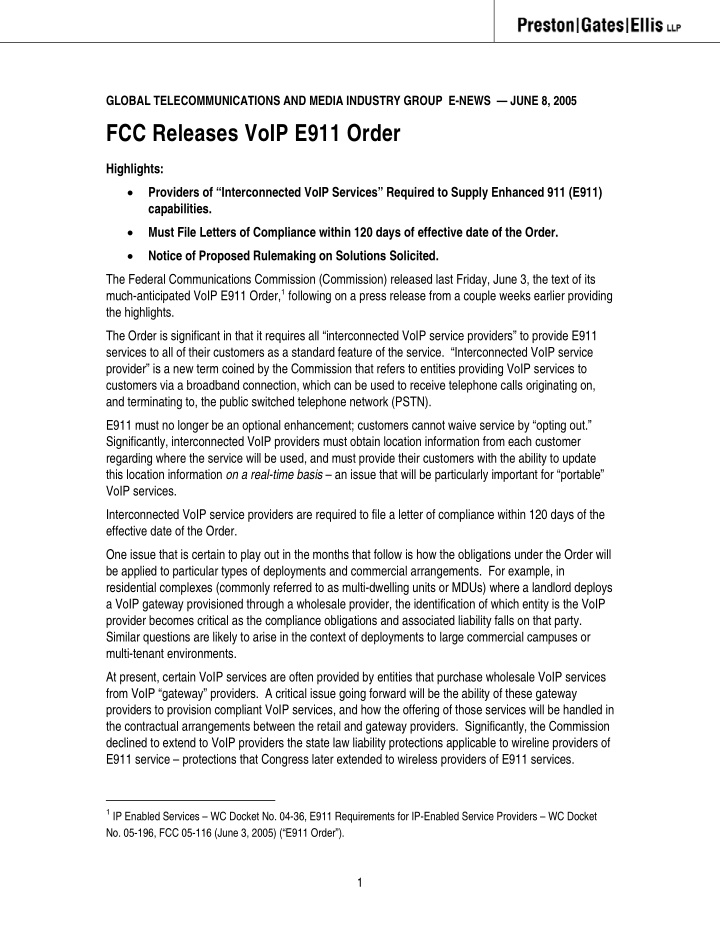



GLOBAL TELECOMMUNICATIONS AND MEDIA INDUSTRY GROUP E-NEWS — JUNE 8, 2005 FCC Releases VoIP E911 Order Highlights: • Providers of “Interconnected VoIP Services” Required to Supply Enhanced 911 (E911) capabilities. • Must File Letters of Compliance within 120 days of effective date of the Order. • Notice of Proposed Rulemaking on Solutions Solicited. The Federal Communications Commission (Commission) released last Friday, June 3, the text of its much-anticipated VoIP E911 Order, 1 following on a press release from a couple weeks earlier providing the highlights. The Order is significant in that it requires all “interconnected VoIP service providers” to provide E911 services to all of their customers as a standard feature of the service. “Interconnected VoIP service provider” is a new term coined by the Commission that refers to entities providing VoIP services to customers via a broadband connection, which can be used to receive telephone calls originating on, and terminating to, the public switched telephone network (PSTN). E911 must no longer be an optional enhancement; customers cannot waive service by “opting out.” Significantly, interconnected VoIP providers must obtain location information from each customer regarding where the service will be used, and must provide their customers with the ability to update this location information on a real-time basis – an issue that will be particularly important for “portable” VoIP services. Interconnected VoIP service providers are required to file a letter of compliance within 120 days of the effective date of the Order. One issue that is certain to play out in the months that follow is how the obligations under the Order will be applied to particular types of deployments and commercial arrangements. For example, in residential complexes (commonly referred to as multi-dwelling units or MDUs) where a landlord deploys a VoIP gateway provisioned through a wholesale provider, the identification of which entity is the VoIP provider becomes critical as the compliance obligations and associated liability falls on that party. Similar questions are likely to arise in the context of deployments to large commercial campuses or multi-tenant environments. At present, certain VoIP services are often provided by entities that purchase wholesale VoIP services from VoIP “gateway” providers. A critical issue going forward will be the ability of these gateway providers to provision compliant VoIP services, and how the offering of those services will be handled in the contractual arrangements between the retail and gateway providers. Significantly, the Commission declined to extend to VoIP providers the state law liability protections applicable to wireline providers of E911 service – protections that Congress later extended to wireless providers of E911 services. 1 IP Enabled Services – WC Docket No. 04-36, E911 Requirements for IP-Enabled Service Providers – WC Docket No. 05-196, FCC 05-116 (June 3, 2005) (“E911 Order”). 1
Addressing this issue is likely to be an additional deal point between retail providers and VoIP gateway providers. For enterprises providing interconnected VoIP services, one interesting open question appears to be the extent to which a caller’s location information will be required at the floor or cubicle level – an issue that already plays out under certain state 911 statutes. The Commission seems intent on pushing the technology to offer E911 service via VoIP to levels that are no less robust than current E911 service. Indeed, the tone of the Order is unambiguous: if VoIP providers are able to provide E911, they must provide E911 at the highest service level available. Further details on the Order are immediately below. BACKGROUND OF E911 SERVICE The Commission noted that 911 service, first made available by AT&T in 1965, is available to 99 percent of the population and that the explosive growth of VoIP service threatens this near ubiquitous coverage. For 911 service, the first call center that answers the call is the public safety answering points (PSAP), which are connected to the telephone network through special trunk lines. 2 Currently, each incumbent and competitive local telecommunications provider is required to have individual lines from its switches to all 911-PSAPs in its service area. E911 obligations are also imposed on wireless providers including real-time location updates, although this service is non-universal at this time. Most VoIP providers, particularly those unaffiliated with local network providers, do not have these lines installed given the relatively high cost (separate lines to each and every PSAP in the country for a national VoIP provider). Generally, basic 911 service requires delivery of the call to the PSAP, where location information can be obtained from the caller. E911 rules require the provision of basic 911 service, as well as the caller’s location and call back numbers. 3 The current E911 wireline network is dedicated, redundant, highly reliable, and interconnected with, but separate from, the PSTN. If an entity is able to provide full E911 service, the Order generally mandates that this entity do so to the full extent of the functionality on a non-optional basis. For example, if a provider provisions E911 services with real-time location updates to IP addresses, it must continue to do so to all subscribers. The Commission realizes that location generally is determined at the router level in IP networks, but is nonetheless requiring those within the scope of the Order to provide E911 services to geographical locations – much as it did when it successfully pushed wireless providers to innovate and provide location information in the wireless E911 order. SCOPE OF THE ORDER The Order applies to those VoIP services that can be used to receive telephone calls that originate on the PSTN and can be used to terminate calls to the PSTN – what the Order terms “interconnected VoIP services.” For purposes of the Order, an interconnected VoIP service has the following characteristics: (1) real-time two-way voice communications; 2 These trunk lines are known as Centralized Automatic Message Accounting (CAMA) trunks. 3 These services are commonly referred to as Automated Location Identification (ALI) database connectivity, and the Automated Number Identification (ANI) system. 2
Recommend
More recommend